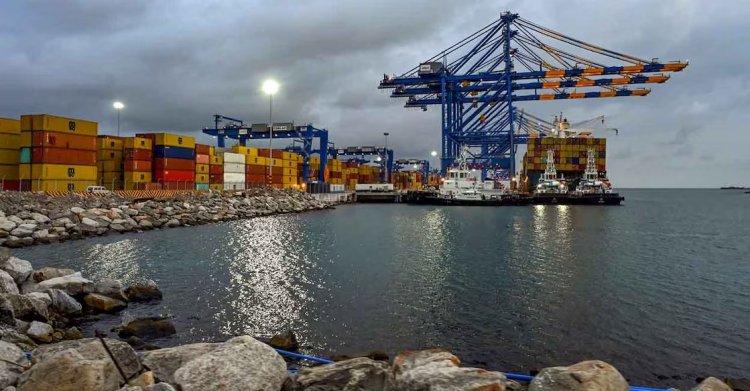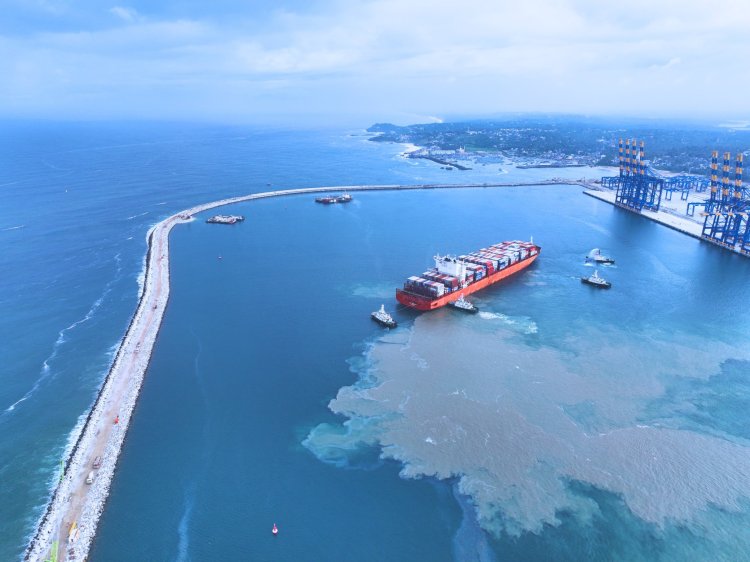Vizhinjam International Seaport: A Game-Changer for India’s Maritime Trade
Explore Vizhinjam International Seaport in Kerala—India’s first deep-sea transshipment port. Learn about its strategic benefits, ownership, ship arrivals, public access, history, and future impact on maritime trade.

The Vizhinjam International Seaport, located in Thiruvananthapuram district, Kerala, is one of India’s most ambitious deep-water port projects. Dubbed a game-changer for Kerala’s economy, the port is set to become a critical node in the global shipping and transshipment network.Designed to become a major transshipment hub in the Indian Ocean region, the port is set to revolutionize India’s maritime trade by reducing dependency on foreign ports like Colombo, Singapore, and Dubai.
What Makes Vizhinjam Port Special?
What sets Vizhinjam Port apart is its natural depth of over 20 meters, allowing it to host ultra-large container ships, or "mother vessels," without the need for significant dredging. It is located just 10 nautical miles from the international east-west shipping route, enabling quicker turnaround times and reduced fuel consumption for vessels. This geographic advantage makes it a unique offering not just in India, but globally.
-
Natural Depth: The port boasts a natural depth of 20-24 meters, making it ideal for handling large mother ships (Megamax vessels).
-
Strategic Location: Positioned just 10 nautical miles from international shipping routes, it offers a competitive advantage in global trade.
-
Modern Infrastructure: Equipped with automated container handling systems, it aims to be one of the most efficient ports in Asia.
-
Transshipment Hub: Expected to divert traffic from Colombo and Singapore, boosting India’s EXIM (Export-Import) trade.
Its strategic location, just 10 nautical miles from key international shipping routes, makes it an ideal hub for global maritime trade. The port boasts semi-automation, remote-controlled quay cranes, and an AI-powered vessel traffic management system developed with IIT Madras, setting new standards in India’s port infrastructure.
Who is the Owner And Operate Vizhinjam Port?
The Adani Group operates the Vizhinjam Seaport under a Public-Private Partnership (PPP) model with the Government of Kerala. The port is being developed by Adani Vizhinjam Port Private Limited (AVPPL). While the infrastructure and land remain under state ownership, the private partner manages and operates the facilities.
The port is developed under a public-private partnership model. Ownership is shared among the Government of Kerala (61.5%), the Government of India (9.6%), and Adani Vizhinjam Port Pvt Ltd (AVPL), a subsidiary of Adani Ports and Special Economic Zone Ltd (28.9%)
-
Developed by: Adani Ports and Special Economic Zone (APSEZ) under a Public-Private Partnership (PPP) model.
-
Government Stakeholders: The Kerala government and the Central government are key stakeholders.
How Many Ships Have Arrived in Vizhinjam Port?
As of early 2025, more than 150 vessels—including container ships, support tugs, and supply carriers—have docked or made test runs at Vizhinjam. The port saw the arrival of its first mothership in October 2023, marking a major milestone in India’s maritime logistics capability.
Since partial operations began in July 2023, Vizhinjam port has handled approximately 250–285 container ships before its formal inauguration in May 2025. This includes the docking of the world’s largest eco-friendly container ship, the Turkiye, operated by the Mediterranean Shipping Company.
-
The first trial ship, San Fernando, arrived in October 2023, marking a historic milestone.
-
The port is expected to handle over 1 million TEUs (Twenty-Foot Equivalent Units) annually in its first phase.

Can the Public Visit Vizhinjam Port?
As of now, Vizhinjam port is a high-security, operational port facility. Public access is generally restricted due to security and operational protocols. There is no official public visiting time announced for casual visits or tourism. Any visits are likely to be limited to official delegations or pre-arranged educational tours.
While the core terminal is a high-security area not open to the public, limited visiting hours and guided tours are occasionally organized by the Kerala Tourism Department. Interested visitors can check the official port or district tourism websites for Vizhinjam port visiting time and permissions.
-
Currently, the port is not open for general public visits due to security and operational reasons.
-
However, official visits and media tours may be permitted with prior approval.
What Are the Negatives of Vizhinjam Port?
While Vizhinjam port brings significant economic and strategic benefits, it has faced criticism and challenges:
-
Environmental Concerns: Construction and dredging have raised worries about coastal erosion and ecological impact.Fishermen and locals protested against coastal erosion and loss of livelihood.
-
Social Impact: Local fishing communities have protested, fearing loss of livelihood and displacement.
-
Political Controversy: The project has seen political disputes, including criticism over the recognition of key contributors and concerns about transparency in the development process.
-
High Project Cost: Estimated at ₹7,700 crore, delays have escalated expenses.
-
Land Acquisition Issues: Protests and legal battles caused delays in construction.
What Are the Benefits of Vizhinjam Port to Kerala?
Vizhinjam port is expected to deliver transformative benefits:
-
Economic Growth: It positions Kerala as a major maritime gateway, attracting global shipping lines and boosting local industries.It is expected to create over 5,000 direct jobs and many more indirect opportunities in logistics, warehousing, and tourism.
-
Job Creation: The port and its ancillary industries are projected to generate thousands of direct and indirect jobs.Expected to generate 5,000+ direct jobs and 1.5 lakh indirect jobs.
-
Reduced Shipping Costs: By serving as a transshipment hub, it will reduce India’s dependence on foreign ports like Colombo, Singapore, and Dubai, lowering logistics costs for Indian exporters and importers.Indian exporters/importers will save $200–300 per container by avoiding transshipment via foreign ports.
-
Infrastructure Development: The port is spurring investment in road, rail, and logistics infrastructure, including a new cloverleaf interchange and NH 66 connectivity.
- Reduced Cargo Dependence: Kerala, which relies on ports in Tamil Nadu and Karnataka, will gain autonomy in maritime trade.
- Export Boost: Local industries, including coir, seafood, electronics, and spices, will benefit from quicker export logistics.
-
Boost to Tourism & Trade: Enhanced connectivity will benefit Kerala’s economy.Local industries, including coir, seafood, electronics, and spices, will benefit from quicker export logistics.
What is the Future of Vizhinjam Port?
Vizhinjam is expected to become India’s primary transshipment hub, challenging global ports like Colombo (Sri Lanka) and Singapore. Once completed, it aims to handle over 1 million TEUs (Twenty-foot Equivalent Units) annually in the initial phase, with further expansions planned. Experts predict the port will redefine India's position in international maritime trade over the next decade.
The port’s future is promising, with plans for major expansion:
-
By 2028–29, Phase 2 will extend the berth by 1,200 meters and increase total capacity to 3 million TEUs annually.
-
Additional investments of over ₹8,500 crore are anticipated to triple cargo handling capacity, further integrating Vizhinjam into global shipping networks.
-
The port is expected to become a key node in Adani’s pan-India port network and a vital link for India’s foreign trade, especially with the US, Europe, Africa, and East Asia.
-
Phase 1 Completion: Expected by 2024, with 3 berths operational.
-
Full Capacity (By 2028): 30 berths, handling 6.2 million TEUs annually.
-
Global Hub Vision: Aims to compete with Colombo, Singapore, and Dubai as a premier transshipment destination.
Milestones of Vizhinjam Port:
-
July 2023: Commencement of trial operations.
-
December 2024: Commercial commissioning certificate granted.
-
May 2, 2025: Formal inauguration by Prime Minister Modi.
-
Integration into MSC’s Jade Service route, connecting Singapore to Europe, marking a major leap in India’s maritime connectivity.
-
2015: Agreement signed with Adani Group
-
2016: Construction begins
-
2023: First mothership arrival
-
2024: Completion of Phase 1 and start of operations
-
2025: Regular commercial cargo movement begins
These milestones underscore the port's transformation from a decades-old dream into a functioning maritime hub.

Which is the Largest Mother Port in the World?
-
Shanghai Port (China) is the world’s largest container port, handling over 47 million TEUs annually.
-
Singapore Port and Shenzhen Port follow closely.
As of 2025, the Port of Shanghai in China holds the title of the largest mother port in the world, handling over 47 million TEUs annually. Vizhinjam aims to follow in such footsteps, though on a smaller but strategic scale for South Asia.
The Port of Shanghai in China is the world’s largest container port, handling 47.3 million TEU (twenty-foot equivalent units) in 2022. It is followed by the Port of Singapore and the Port of Ningbo-Zhoushan, also in China.
Vizhinjam Port Key Details:
The idea of developing Vizhinjam as a deep-sea port dates back to the 1990s. However, multiple delays due to environmental concerns, land acquisition issues, and legal challenges stalled the project. It finally gained momentum in 2015, when the Kerala government signed an agreement with the Adani Group. Construction began in earnest in December 2015.
It was historically significant as a port under the Ay dynasty and later developed by Raja Kesava Das, Dewan of Travancore. Archaeological excavations have revealed remnants of ancient forts and trading posts, underscoring its long-standing maritime legacy.
-
Vizhinjam Port District: Thiruvananthapuram, Kerala
-
Vizhinjam Port Visiting Time: Not open to the public (official visits only)
-
Vizhinjam Port History:
-
Conceptualized in 1991 but delayed due to funding and political issues.
-
Construction began in 2015 under a PPP model.
-
Major delays due to protests, environmental concerns, and land disputes.
-
What are the main features of Vizhinjam port:
1. Deep Natural Draft and Minimal Dredging:
-
Vizhinjam port boasts a natural depth of up to 20–24 meters, allowing it to accommodate the world’s largest container ships, including vessels with capacities exceeding 18,000 TEUs.
-
This deep draft minimizes the need for maintenance dredging due to negligible littoral sedimentation, reducing operational costs and environmental impact
2. Strategic Location:
-
The port is situated just 10 nautical miles from the international east-west shipping route, making it one of the closest Indian ports to major global maritime trade lanes.
-
Its proximity to these routes enables it to serve as a natural transshipment hub, attracting large vessels that previously bypassed India for ports like Colombo, Singapore, and Dubai.
3. Transshipment Hub:
-
Vizhinjam is India’s first dedicated deep-water container transshipment port, designed to transfer containers from large mother vessels to smaller feeder ships for distribution to regional ports.
-
The port has already handled over 285 ships and processed more than 593,000 TEUs before its formal commissioning, demonstrating high operational efficiency.
4. Advanced Infrastructure and Technology:
-
The port is semi-automated, featuring remote-controlled quay cranes and India’s first AI-powered Vessel Traffic Management System, developed in collaboration with IIT Madras.
-
Phase 1 includes an 1,800-meter container ship berth, with future expansions planned to increase capacity and berth length.
-
The port is equipped to handle luxury cruise ships, with dedicated cruise and multipurpose berths, and facilities for the Indian Navy and Coast Guard.
5. Large Handling Capacity And Scalability:
-
The initial annual handling capacity is 1.5–3 million TEUs, with plans to scale up to 5 million TEUs and potentially 7.2 million TEUs in subsequent phases.
-
The port’s infrastructure is designed to be scalable, supporting future growth in cargo volumes.
6. Connectivity:
-
Vizhinjam port is well-connected to national highways (NH 47) and is near major rail networks, facilitating efficient cargo movement inland.
-
A new railway link and Kerala’s first cloverleaf interchange are under development to support logistics traffic.
7. Public-Private Partnership (PPP) Model:
The port is developed under a landlord model with a PPP component, involving Adani Ports and Special Economic Zone Ltd (APSEZ) and significant investment from the Kerala government.
8. All Weather Operations:
Vizhinjam is an all-weather port, capable of year-round operations due to its favorable coastal conditions and minimal siltation.
9. Enviornmental And Economy Efficiwency:
-
Minimal littoral drift and sedimentation reduce the need for frequent dredging, enhancing environmental sustainability.
-
The port is expected to lower shipping and logistics costs for Indian exporters and importers by reducing dependence on foreign transshipment hubs.
10. Future Expansion and Globa, integration:
-
By 2028–29, Phase 2 will further expand berth length and cargo handling capacity, strengthening Vizhinjam’s role as a global maritime gateway.
-
The port is already integrated into major international shipping lines, including MSC’s Jade Service route connecting Singapore to Europe.
Summery Table: Key Features of Vizhinjam port:
| Feature | Details |
|---|---|
| Natural Draft | 20–24 meters (accommodates largest ships) |
| Location | Thiruvananthapuram, Kerala; 10 nautical miles from major shipping route |
| Transshipment Capacity | 1.5–3 million TEUs (Phase 1); scalable up to 7.2 million TEUs |
| Infrastructure | Semi-automated, AI-powered systems, advanced quay cranes, cruise and naval berths |
| Connectivity | NH 47, planned railway link, proximity to major rail and road networks |
| Ownership Model | Public-Private Partnership (Adani Ports & Kerala Govt.) |
| Environmental Advantage | Minimal dredging, negligible littoral drift |
| Operational Milestones | Over 285 ships handled before inauguration; integrated into global shipping networks |
Vizhinjam port’s combination of deep natural draft, strategic location, advanced technology, and scalable infrastructure positions it as a transformative asset for India’s maritime trade.
Vizhinjam port FAQ:
Vizhinjam port news:
The port’s inauguration has been widely covered, highlighting its strategic importance, cutting-edge technology, and the political and social debates surrounding its development.
Vizhinjam Port which district:
Vizhinjam port is located in Thiruvananthapuram district, Kerala
Vizhinjam port visiting time:
There is no public visiting time; the port is not open for casual visits due to security and operational reasons.
Conclusion
The Vizhinjam International Seaport is set to be a transformational project for India’s maritime trade, reducing dependency on foreign ports and boosting Kerala’s economy. Despite challenges, its strategic location and world-class infrastructure position it as a future global transshipment hub.While it faces challenges, its strategic advantages and future expansion plans position it as a potential game-changer in global shipping and trade.
The Vizhinjam Port news continues to capture national attention as Kerala positions itself as a central player in India's maritime future. While challenges remain, the port’s deep-sea advantage, logistical promise, and future-ready infrastructure give it immense potential to transform regional trade.

 Editor
Editor 






























